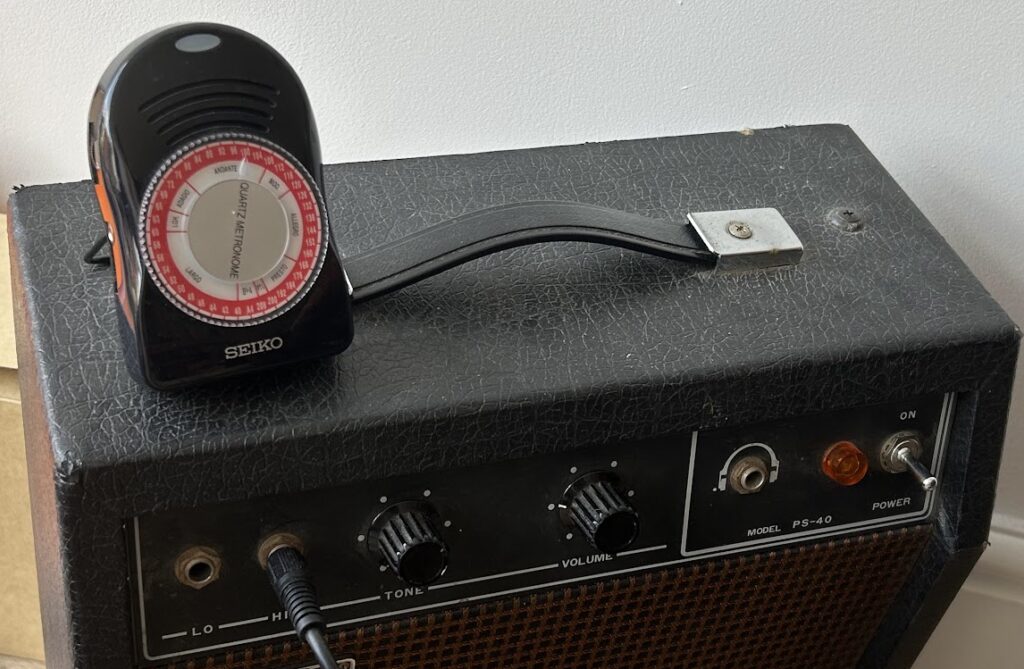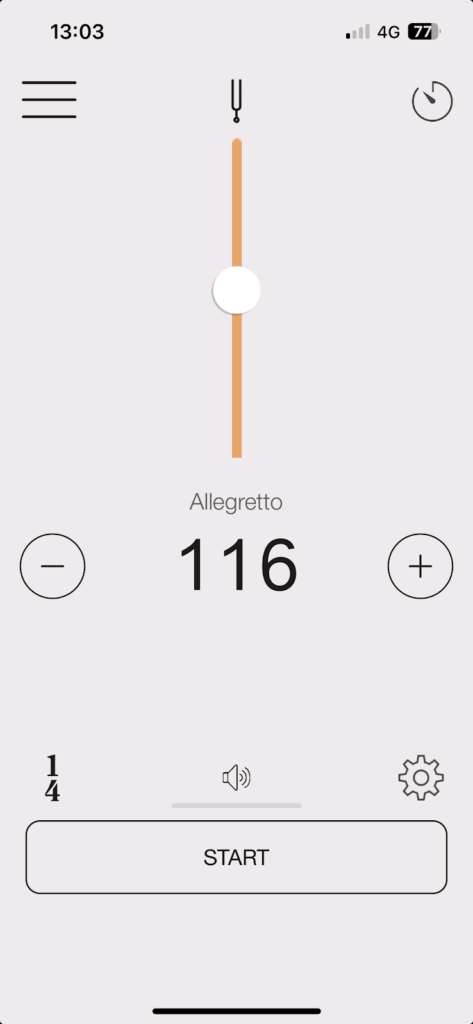A regular question that I ask in workshops and class etching is “Who uses a metronome”, and I am always surprised by the number of people who don’t. For me, it is one of the most useful pieces of equipment at I have, and I almost never practice without it.
Most metronomes now are electronic, either battery or usb powered, and will have something to adjust the click rate. The original metronomes were clockwork, with a physical swinging pendulum. There is nothing wrong with these, (and I have one myself on top of the piano) but it is important to make sure atht they are level, otherwise the click will be uneven.

The metronome I use at home is a basic battery powered one, with a dial on the front that sets the click speed. There’s also a mini jack socket which means that you can plug it into an amp if you want make it louder (although I have never needed to do that !).
If you haven’t got a metronome, there are many perfectly good free smart phone apps available. I have this on on my iPhone which I use when I am away from home, and to be honest, is just as good as my physical one.

Whichever type of metronome you use, the principal is still the same;
- Choose an appropriate tempo
- Decide where the click should be
Choose an appropriate tempo
“Start Slow”.
The metronome tempo should be set to a slow enough speed that you can play thorough the piece of music that you are practicing without making a mistake (see How To Practice for more advice about this).
Its really important to listen to the metronome why you are playing to make sure that you are keeping in time. Have you ever heard someone say “My metronome doesn’t stay in time”? Guess what, it does! One simple way of making sure that you are keeping in step with the click is to record yourself – its deceptively easy to fool yourself into thinking that you are keeping time when you are not.
Once you can play something without any mistakes (use the ‘Rule of Seven‘) at one speed, make the click a bit faster and try again. As soon as you get to a speed where you are making mistakes, or not keeping in time, slow it back down again.
Decide where the click should be
As an example, lets take practicing the scale og G major, up and down the octave. The sequence of notes that we will be playing will be
G – A – B – C – D- E- F# – G – G – F# – E – D- C- B – A – G
(Note that we are repeating the root each time in order to bet a multiple of four notes, which will become more apprant in a minute.)
Set the click to a slow speed – e.g. 50 BPM – and play along with it. Before you start, listen to the clicks, and count “one – two – three – four” to make sure that you are locked in with the tempo.
Play each note of the scale in time with the click, and listen carefully – your note and the click should coincide exactly. This is a really good time to record yourself to double check. Once you can do it repeatedly without making a mistake, the increase the tempo by 5 BPM. Try and resist the temptation to mask a big change in tempo.
Once you are confident with playing against a click on every beat, try and set the tempo so it clicks on every other beat. For example, if you can play without making a mistake at 80 BPM;
- Set the tempo to 40 BPM
- Start the metronome going and count “one – two -three – four” so that the click coincides on “one” and three”
- Start playing the scale so that the click matches one note out of two – e.g. (for the scale of G) where the notes are in bold below;
G – A– B – C – D – E – F# – G – G – F# – E – D – C – B – A – G
Now that you are not playing one note per click (i.e. every other note doesn’t have a click against it) it becomes super important to make sure taht the notes without a click are in time – i.e. not rushing or dragging, and again, recording yourself will be really useful at this point.
Once you can do this successfully, an especially as you start to get faster, try setting the metronome so that you are clicking against the first note out of four.
Doubling Tempo
You can use a combination of the above, as a really good way of avoiding speeding up in fast sections (a very common fault). Set the metronome to a relatively slow speed (e.g. 50 BPM, and then practice the section, playing it ounce with one click per note, and then at double speed (i.e. one click on the first of every two notes) before reverting back to the slow speed. Keep on alternating between the two and ask yourself;
- Am I always playing against the click when I should be?
- When I return to the slow speed am I playing one note exactly at the same time as each click
To really push yourself, try adding in one click for every four notes!

Use The Off Beat
You don’t just have to have the click on the first beat of the bar, and for bass especially, its really good to set it on beats 2 and 4 (e.g. to replicate the mando chop in bluegrass, or the snare beat in rock music. When you do this its really important that you feel where beat one is before you start. Taking our scale of G as an example;
- Set the tempo to 50 BPM and start the metronome
- Listen to the beat and start counting “one – two – three – four ” so that two and four match the click.
- (Hint – if you find this is difficult, start on “two” at a metronome click ..)
- Do not start playing yet, but carry on counting, tapping your foot on “one” and “three” and clapping on “two” and “four“
- Only start to play once you are confident that you are accuratly feeling and counting the correct beat against the click
- Play the scale so that every other note matches the click (e.g. the clicks will be in bold below) – i.e. on A – C – E ….)
G – A – B – C – D – E– F# – G – G – F# – E – D – C – B – A – G
You can take this further by using more off bet notes e.g. just on the forth beat of the bar, or just on the anticipation beat on a swing tempo. Try setting it to every eighth beat in the scale sequence, which will be a real test of whether or note you are stying in tempo.